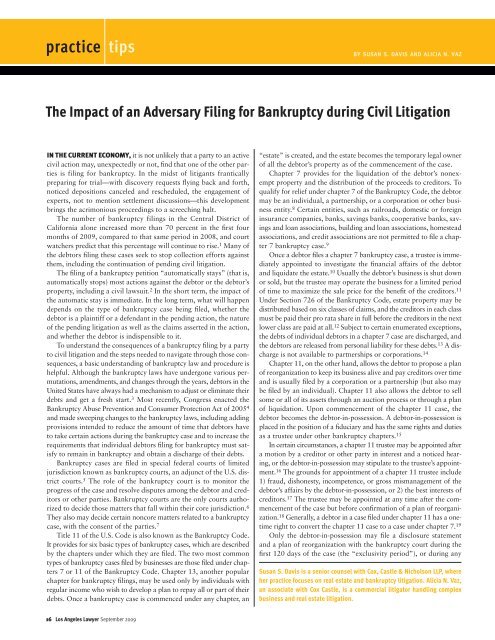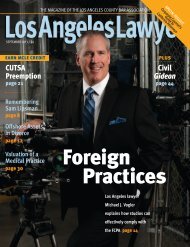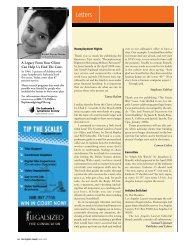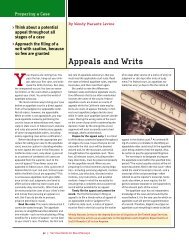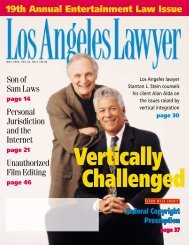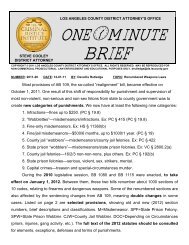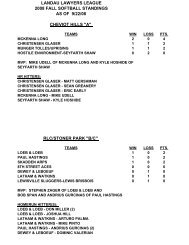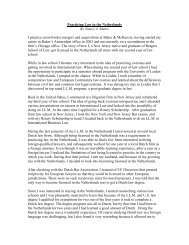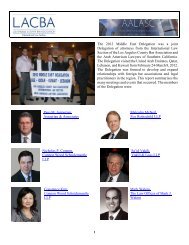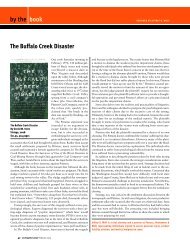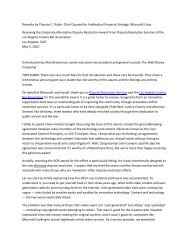The impact of an adversary filing for bankruptcy during civil litigation
The impact of an adversary filing for bankruptcy during civil litigation
The impact of an adversary filing for bankruptcy during civil litigation
Create successful ePaper yourself
Turn your PDF publications into a flip-book with our unique Google optimized e-Paper software.
practice tips<br />
BY SUSAN S. DAVIS AND ALICIA N. VAZ<br />
<strong>The</strong> Impact <strong>of</strong> <strong>an</strong> Adversary Filing <strong>for</strong> B<strong>an</strong>kruptcy <strong>during</strong> Civil Litigation<br />
IN THE CURRENT ECONOMY, it is not unlikely that a party to <strong>an</strong> active<br />
<strong>civil</strong> action may, unexpectedly or not, find that one <strong>of</strong> the other parties<br />
is <strong>filing</strong> <strong>for</strong> b<strong>an</strong>kruptcy. In the midst <strong>of</strong> litig<strong>an</strong>ts fr<strong>an</strong>tically<br />
preparing <strong>for</strong> trial—with discovery requests flying back <strong>an</strong>d <strong>for</strong>th,<br />
noticed depositions c<strong>an</strong>celed <strong>an</strong>d rescheduled, the engagement <strong>of</strong><br />
experts, not to mention settlement discussions—this development<br />
brings the acrimonious proceedings to a screeching halt.<br />
<strong>The</strong> number <strong>of</strong> b<strong>an</strong>kruptcy <strong>filing</strong>s in the Central District <strong>of</strong><br />
Cali<strong>for</strong>nia alone increased more th<strong>an</strong> 70 percent in the first four<br />
months <strong>of</strong> 2009, compared to that same period in 2008, <strong>an</strong>d court<br />
watchers predict that this percentage will continue to rise. 1 M<strong>an</strong>y <strong>of</strong><br />
the debtors <strong>filing</strong> these cases seek to stop collection ef<strong>for</strong>ts against<br />
them, including the continuation <strong>of</strong> pending <strong>civil</strong> <strong>litigation</strong>.<br />
<strong>The</strong> <strong>filing</strong> <strong>of</strong> a b<strong>an</strong>kruptcy petition “automatically stays” (that is,<br />
automatically stops) most actions against the debtor or the debtor’s<br />
property, including a <strong>civil</strong> lawsuit. 2 In the short term, the <strong>impact</strong> <strong>of</strong><br />
the automatic stay is immediate. In the long term, what will happen<br />
depends on the type <strong>of</strong> b<strong>an</strong>kruptcy case being filed, whether the<br />
debtor is a plaintiff or a defend<strong>an</strong>t in the pending action, the nature<br />
<strong>of</strong> the pending <strong>litigation</strong> as well as the claims asserted in the action,<br />
<strong>an</strong>d whether the debtor is indispensible to it.<br />
To underst<strong>an</strong>d the consequences <strong>of</strong> a b<strong>an</strong>kruptcy <strong>filing</strong> by a party<br />
to <strong>civil</strong> <strong>litigation</strong> <strong>an</strong>d the steps needed to navigate through those consequences,<br />
a basic underst<strong>an</strong>ding <strong>of</strong> b<strong>an</strong>kruptcy law <strong>an</strong>d procedure is<br />
helpful. Although the b<strong>an</strong>kruptcy laws have undergone various permutations,<br />
amendments, <strong>an</strong>d ch<strong>an</strong>ges through the years, debtors in the<br />
United States have always had a mech<strong>an</strong>ism to adjust or eliminate their<br />
debts <strong>an</strong>d get a fresh start. 3 Most recently, Congress enacted the<br />
B<strong>an</strong>kruptcy Abuse Prevention <strong>an</strong>d Consumer Protection Act <strong>of</strong> 2005 4<br />
<strong>an</strong>d made sweeping ch<strong>an</strong>ges to the b<strong>an</strong>kruptcy laws, including adding<br />
provisions intended to reduce the amount <strong>of</strong> time that debtors have<br />
to take certain actions <strong>during</strong> the b<strong>an</strong>kruptcy case <strong>an</strong>d to increase the<br />
requirements that individual debtors <strong>filing</strong> <strong>for</strong> b<strong>an</strong>kruptcy must satisfy<br />
to remain in b<strong>an</strong>kruptcy <strong>an</strong>d obtain a discharge <strong>of</strong> their debts.<br />
B<strong>an</strong>kruptcy cases are filed in special federal courts <strong>of</strong> limited<br />
jurisdiction known as b<strong>an</strong>kruptcy courts, <strong>an</strong> adjunct <strong>of</strong> the U.S. district<br />
courts. 5 <strong>The</strong> role <strong>of</strong> the b<strong>an</strong>kruptcy court is to monitor the<br />
progress <strong>of</strong> the case <strong>an</strong>d resolve disputes among the debtor <strong>an</strong>d creditors<br />
or other parties. B<strong>an</strong>kruptcy courts are the only courts authorized<br />
to decide those matters that fall within their core jurisdiction. 6<br />
<strong>The</strong>y also may decide certain noncore matters related to a b<strong>an</strong>kruptcy<br />
case, with the consent <strong>of</strong> the parties. 7<br />
Title 11 <strong>of</strong> the U.S. Code is also known as the B<strong>an</strong>kruptcy Code.<br />
It provides <strong>for</strong> six basic types <strong>of</strong> b<strong>an</strong>kruptcy cases, which are described<br />
by the chapters under which they are filed. <strong>The</strong> two most common<br />
types <strong>of</strong> b<strong>an</strong>kruptcy cases filed by businesses are those filed under chapters<br />
7 or 11 <strong>of</strong> the B<strong>an</strong>kruptcy Code. Chapter 13, <strong>an</strong>other popular<br />
chapter <strong>for</strong> b<strong>an</strong>kruptcy <strong>filing</strong>s, may be used only by individuals with<br />
regular income who wish to develop a pl<strong>an</strong> to repay all or part <strong>of</strong> their<br />
debts. Once a b<strong>an</strong>kruptcy case is commenced under <strong>an</strong>y chapter, <strong>an</strong><br />
“estate” is created, <strong>an</strong>d the estate becomes the temporary legal owner<br />
<strong>of</strong> all the debtor’s property as <strong>of</strong> the commencement <strong>of</strong> the case.<br />
Chapter 7 provides <strong>for</strong> the liquidation <strong>of</strong> the debtor’s nonexempt<br />
property <strong>an</strong>d the distribution <strong>of</strong> the proceeds to creditors. To<br />
qualify <strong>for</strong> relief under chapter 7 <strong>of</strong> the B<strong>an</strong>kruptcy Code, the debtor<br />
may be <strong>an</strong> individual, a partnership, or a corporation or other business<br />
entity. 8 Certain entities, such as railroads, domestic or <strong>for</strong>eign<br />
insur<strong>an</strong>ce comp<strong>an</strong>ies, b<strong>an</strong>ks, savings b<strong>an</strong>ks, cooperative b<strong>an</strong>ks, savings<br />
<strong>an</strong>d lo<strong>an</strong> associations, building <strong>an</strong>d lo<strong>an</strong> associations, homestead<br />
associations, <strong>an</strong>d credit associations are not permitted to file a chapter<br />
7 b<strong>an</strong>kruptcy case. 9<br />
Once a debtor files a chapter 7 b<strong>an</strong>kruptcy case, a trustee is immediately<br />
appointed to investigate the fin<strong>an</strong>cial affairs <strong>of</strong> the debtor<br />
<strong>an</strong>d liquidate the estate. 10 Usually the debtor’s business is shut down<br />
or sold, but the trustee may operate the business <strong>for</strong> a limited period<br />
<strong>of</strong> time to maximize the sale price <strong>for</strong> the benefit <strong>of</strong> the creditors. 11<br />
Under Section 726 <strong>of</strong> the B<strong>an</strong>kruptcy Code, estate property may be<br />
distributed based on six classes <strong>of</strong> claims, <strong>an</strong>d the creditors in each class<br />
must be paid their pro rata share in full be<strong>for</strong>e the creditors in the next<br />
lower class are paid at all. 12 Subject to certain enumerated exceptions,<br />
the debts <strong>of</strong> individual debtors in a chapter 7 case are discharged, <strong>an</strong>d<br />
the debtors are released from personal liability <strong>for</strong> these debts. 13 A discharge<br />
is not available to partnerships or corporations. 14<br />
Chapter 11, on the other h<strong>an</strong>d, allows the debtor to propose a pl<strong>an</strong><br />
<strong>of</strong> reorg<strong>an</strong>ization to keep its business alive <strong>an</strong>d pay creditors over time<br />
<strong>an</strong>d is usually filed by a corporation or a partnership (but also may<br />
be filed by <strong>an</strong> individual). Chapter 11 also allows the debtor to sell<br />
some or all <strong>of</strong> its assets through <strong>an</strong> auction process or through a pl<strong>an</strong><br />
<strong>of</strong> liquidation. Upon commencement <strong>of</strong> the chapter 11 case, the<br />
debtor becomes the debtor-in-possession. A debtor-in-possession is<br />
placed in the position <strong>of</strong> a fiduciary <strong>an</strong>d has the same rights <strong>an</strong>d duties<br />
as a trustee under other b<strong>an</strong>kruptcy chapters. 15<br />
In certain circumst<strong>an</strong>ces, a chapter 11 trustee may be appointed after<br />
a motion by a creditor or other party in interest <strong>an</strong>d a noticed hearing,<br />
or the debtor-in-possession may stipulate to the trustee’s appointment.<br />
16 <strong>The</strong> grounds <strong>for</strong> appointment <strong>of</strong> a chapter 11 trustee include<br />
1) fraud, dishonesty, incompetence, or gross mism<strong>an</strong>agement <strong>of</strong> the<br />
debtor’s affairs by the debtor-in-possession, or 2) the best interests <strong>of</strong><br />
creditors. 17 <strong>The</strong> trustee may be appointed at <strong>an</strong>y time after the commencement<br />
<strong>of</strong> the case but be<strong>for</strong>e confirmation <strong>of</strong> a pl<strong>an</strong> <strong>of</strong> reorg<strong>an</strong>ization.<br />
18 Generally, a debtor in a case filed under chapter 11 has a onetime<br />
right to convert the chapter 11 case to a case under chapter 7. 19<br />
Only the debtor-in-possession may file a disclosure statement<br />
<strong>an</strong>d a pl<strong>an</strong> <strong>of</strong> reorg<strong>an</strong>ization with the b<strong>an</strong>kruptcy court <strong>during</strong> the<br />
first 120 days <strong>of</strong> the case (the “exclusivity period”), or <strong>during</strong> <strong>an</strong>y<br />
Sus<strong>an</strong> S. Davis is a senior counsel with Cox, Castle & Nicholson LLP, where<br />
her practice focuses on real estate <strong>an</strong>d b<strong>an</strong>kruptcy <strong>litigation</strong>. Alicia N. Vaz,<br />
<strong>an</strong> associate with Cox Castle, is a commercial litigator h<strong>an</strong>dling complex<br />
business <strong>an</strong>d real estate <strong>litigation</strong>.<br />
16 Los Angeles Lawyer September 2009
When the pressure is on,<br />
GREAT<br />
LAWYERS<br />
rise to the occasion.<br />
This is Elizabeth Y<strong>an</strong>g, Associate with Howrey LLP,<br />
one <strong>of</strong> the largest international law firms in Los Angeles <strong>an</strong>d Class <strong>of</strong> 2006 graduate.<br />
Read Elizabeth’s story at<br />
www.go2lavernelaw.com/elizabeth<br />
<strong>The</strong> University <strong>of</strong> La Verne College <strong>of</strong> Law has been provisionally approved by the Council <strong>of</strong> the Section <strong>of</strong> Legal Education <strong>an</strong>d Admissions to the Bar <strong>of</strong> the<br />
Americ<strong>an</strong> Bar Association since 2006. <strong>The</strong> Section <strong>of</strong> Legal Education may be contacted at 321 North Clark Street, Chicago, IL 60610 or by phone at (312) 988-6738.
– EXPERT WITNESS –<br />
CONSTRUCTION<br />
41 YEARS<br />
CONSTRUCTION EXPERIENCE<br />
SPECIALTIES:<br />
Lawsuit Preparation/Residential<br />
Construction, Single <strong>an</strong>d Multi-family,<br />
Hillside Construction, Foundations,<br />
Vibration Trespass, Concrete, Floors, Tile,<br />
Stone, Retaining Walls, Waterpro<strong>of</strong>ing,<br />
Water Damages, Ro<strong>of</strong>ing, Sheet Metal,<br />
Carpentry/Rough Framing, Stairs,<br />
Materials/Costs, Building Codes,<br />
Construction Contracts.<br />
CIVIL EXPERIENCE:<br />
Construction defect cases <strong>for</strong> insur<strong>an</strong>ce<br />
comp<strong>an</strong>ies <strong>an</strong>d attorneys since 1992<br />
COOK<br />
CONSTRUCTION COMPANY<br />
STEPHEN M. COOK<br />
Cali<strong>for</strong>nia Contractors License B431852<br />
Nevada Contractors License B0070588<br />
Graduate study in Construction<br />
L.A. Business College, 1972<br />
Tel: 818-438-4535 Fax: 818-595-0028<br />
Email: scook16121@aol.com<br />
7131 Owensmouth Avenue, C<strong>an</strong>oga Park, CA 91303<br />
extension <strong>of</strong> the exclusivity period, not to<br />
exceed 18 months. 20 After the exclusivity<br />
period, <strong>an</strong>y party in interest, such as individual<br />
creditors or a creditors’ committee,<br />
may file a pl<strong>an</strong> <strong>of</strong> reorg<strong>an</strong>ization. 21 Under certain<br />
circumst<strong>an</strong>ces, a pl<strong>an</strong> <strong>of</strong> reorg<strong>an</strong>ization<br />
may be “crammed down” on objecting creditors<br />
<strong>an</strong>d confirmed by the b<strong>an</strong>kruptcy court<br />
despite the objections <strong>of</strong> creditors. 22 Confirmation<br />
<strong>of</strong> a reorg<strong>an</strong>ization pl<strong>an</strong> by the<br />
b<strong>an</strong>kruptcy court generally discharges the<br />
debtor from <strong>an</strong>y debt that arose be<strong>for</strong>e the<br />
date <strong>of</strong> confirmation. 23 <strong>The</strong> confirmed pl<strong>an</strong><br />
creates new contractual rights, replacing or<br />
superseding pre-b<strong>an</strong>kruptcy contracts, <strong>an</strong>d the<br />
b<strong>an</strong>kruptcy court retains jurisdiction to<br />
en<strong>for</strong>ce those rights. 24<br />
Imposition <strong>of</strong> <strong>an</strong>d Relief from the<br />
Automatic Stay<br />
When a b<strong>an</strong>kruptcy case is first filed, the<br />
b<strong>an</strong>kruptcy court will send out a notice <strong>of</strong> the<br />
commencement <strong>of</strong> the case to all parties listed<br />
as creditors <strong>an</strong>d interested parties on the<br />
debtor’s schedules. <strong>The</strong> debtor’s counsel is<br />
required to notify other parties to pending<br />
<strong>civil</strong> <strong>litigation</strong> as well as the court in which<br />
the <strong>litigation</strong> is pending that a party to the <strong>litigation</strong><br />
filed a b<strong>an</strong>kruptcy case <strong>an</strong>d the <strong>litigation</strong><br />
is stayed. 25 <strong>The</strong> Judicial Council has<br />
created a <strong>for</strong>m to notify a Cali<strong>for</strong>nia court in<br />
which a <strong>civil</strong> action is pending <strong>of</strong> the stay. 26<br />
If the debtor’s counsel does not notify the<br />
court, the other parties to the <strong>litigation</strong> may<br />
have a duty to do so. 27<br />
<strong>The</strong> <strong>filing</strong> <strong>of</strong> a b<strong>an</strong>kruptcy case by a party<br />
to pending <strong>litigation</strong> automatically <strong>an</strong>d immediately<br />
stops that <strong>litigation</strong> as to the debtor<br />
<strong>an</strong>d its property, whether or not the other<br />
party to the <strong>litigation</strong> has actual notice <strong>of</strong> the<br />
b<strong>an</strong>kruptcy. 28 Since the automatic stay only<br />
bars actions against the debtor, a <strong>civil</strong> action<br />
brought by the debtor (that is, when the<br />
debtor is the plaintiff) is not affected by the<br />
automatic stay <strong>an</strong>d may proceed to judgment.<br />
29 <strong>The</strong> parties against whom the debtor’s<br />
<strong>civil</strong> action is brought do not need relief from<br />
the automatic stay to defend that action. 30<br />
Among other things, the automatic stay<br />
prohibits:<br />
• <strong>The</strong> commencement or continuation <strong>of</strong><br />
suits against the debtor.<br />
• Any action to create, perfect, or en<strong>for</strong>ce a<br />
lien against property <strong>of</strong> the estate.<br />
• Any action to obtain possession <strong>of</strong>, or to<br />
exert control over, property <strong>of</strong> the estate.<br />
• Any set<strong>of</strong>f against property <strong>of</strong> the estate.<br />
• Any action to collect, assess, or recover a<br />
claim against the debtor that arose be<strong>for</strong>e<br />
the commencement <strong>of</strong> the b<strong>an</strong>kruptcy case. 31<br />
<strong>The</strong>re are, however, numerous exceptions<br />
to the automatic stay that are set <strong>for</strong>th in 11<br />
U.S.C. Section 362(b). <strong>The</strong> 28 multipart<br />
exceptions include:<br />
1) Civil actions to determine paternity, domestic<br />
support obligations, marital dissolution,<br />
or child custody.<br />
2) Actions by the government related to the<br />
stockpiling <strong>of</strong> chemical weapons.<br />
3) <strong>The</strong> exercise <strong>of</strong> certain contractual rights<br />
by commodity brokers, <strong>for</strong>ward contract<br />
merch<strong>an</strong>ts, stockbrokers, fin<strong>an</strong>cial institutions,<br />
fin<strong>an</strong>cial particip<strong>an</strong>ts, or securities<br />
clearing agencies.<br />
4) <strong>The</strong> exercise <strong>of</strong> certain contractual rights<br />
by a repossession or fin<strong>an</strong>cial particip<strong>an</strong>t.<br />
5) Criminal actions.<br />
6) Tax audits.<br />
7) Any act by the lessor under a lease <strong>of</strong> nonresidential<br />
real property that terminated by<br />
the expiration <strong>of</strong> the stated term <strong>of</strong> the lease<br />
be<strong>for</strong>e the case was commenced or <strong>during</strong> the<br />
case to obtain possession <strong>of</strong> the real property.<br />
8) Actions to en<strong>for</strong>ce a lien in real property<br />
if the debtor is ineligible to be a debtor or if<br />
the case was filed in violation <strong>of</strong> a b<strong>an</strong>kruptcy<br />
order in a prior case prohibiting the<br />
debtor from being a debtor in <strong>an</strong>other case. 32<br />
<strong>The</strong> automatic stay remains in effect until<br />
the property is no longer part <strong>of</strong> the estate,<br />
the case is closed or dismissed, or a party<br />
obtains relief from the stay. 33<br />
Generally, actions taken in violation <strong>of</strong> the<br />
automatic stay are void. Moreover, a party<br />
may be liable <strong>for</strong> s<strong>an</strong>ctions <strong>for</strong> violating the<br />
automatic stay, even if the violation was inadvertent.<br />
A willful violation <strong>of</strong> a stay entitles<br />
the debtor to recover actual damages, including<br />
costs <strong>an</strong>d attorney’s fees <strong>an</strong>d, in appropriate<br />
circumst<strong>an</strong>ces, punitive damages. 34<br />
As a result, a party to pending <strong>litigation</strong><br />
must obtain relief from the automatic stay in<br />
the b<strong>an</strong>kruptcy court be<strong>for</strong>e continuing <strong>an</strong>y<br />
action against the debtor or <strong>an</strong>y action that<br />
would affect property <strong>of</strong> the debtor’s estate.<br />
Although a debtor prosecuting a <strong>civil</strong> action<br />
does not need relief from the automatic stay<br />
to continue with the <strong>litigation</strong> through judgment,<br />
a debtor may need relief from the automatic<br />
stay to prosecute <strong>an</strong> appeal in which the<br />
underlying action was commenced by a nondebtor<br />
party. 35<br />
To obtain relief from the automatic stay,<br />
a litig<strong>an</strong>t must file a noticed motion in the<br />
b<strong>an</strong>kruptcy court, present evidence in support<br />
<strong>of</strong> the motion, <strong>an</strong>d participate in one or more<br />
hearings. 36 Some b<strong>an</strong>kruptcy courts, including<br />
the Central, Northern, Eastern, <strong>an</strong>d<br />
Southern Districts <strong>of</strong> Cali<strong>for</strong>nia, have <strong>of</strong>ficial<br />
<strong>for</strong>ms to be used in conjunction with a motion<br />
<strong>for</strong> relief from the automatic stay. <strong>The</strong> use <strong>of</strong><br />
motion <strong>for</strong>ms is m<strong>an</strong>datory in the b<strong>an</strong>kruptcy<br />
courts in the Central District. 37<br />
<strong>The</strong> B<strong>an</strong>kruptcy Code provides three<br />
grounds <strong>for</strong> a court to gr<strong>an</strong>t relief from the<br />
automatic stay or to modify the stay. First,<br />
relief from the automatic stay may be gr<strong>an</strong>ted<br />
<strong>for</strong> cause including, but not limited to, lack<br />
18 Los Angeles Lawyer September 2009
<strong>of</strong> adequate protection. 38 Cause may also<br />
exist if the case was filed in bad faith, such as<br />
solely <strong>for</strong> delay or if fraud is involved. Second,<br />
relief may be gr<strong>an</strong>ted if the debtor does not<br />
have <strong>an</strong>y equity in the property at issue <strong>an</strong>d<br />
the property is not necessary <strong>for</strong> the debtor’s<br />
reorg<strong>an</strong>ization. 39 <strong>The</strong> issue <strong>of</strong> <strong>an</strong> effective<br />
reorg<strong>an</strong>ization is a complex factual determination<br />
based upon the nature <strong>of</strong> the collateral,<br />
the nature <strong>of</strong> the debtor’s business, <strong>an</strong>d the<br />
debtor’s prospects <strong>for</strong> a successful reorg<strong>an</strong>ization.<br />
Indeed, resolution <strong>of</strong> this issue c<strong>an</strong><br />
require one or more evidentiary hearings.<br />
Finally, in a “single asset real estate” case, the<br />
court should gr<strong>an</strong>t relief from the stay to<br />
those parties whose claims are secured by<br />
<strong>an</strong> interest in the property, unless not later<br />
th<strong>an</strong> 90 days after the order <strong>for</strong> relief is<br />
entered, the debtor 1) files a pl<strong>an</strong> <strong>of</strong> reorg<strong>an</strong>ization<br />
that has a reasonable possibility <strong>of</strong><br />
being confirmed in a reasonable time, or 2)<br />
has commenced monthly payments at the<br />
nondefault contract rate. 40<br />
<strong>The</strong> likelihood <strong>of</strong> prevailing on a motion<br />
<strong>for</strong> relief from the automatic stay to continue<br />
<strong>litigation</strong> against a b<strong>an</strong>krupt litig<strong>an</strong>t<br />
depends on several factors, such as whether<br />
the <strong>litigation</strong> c<strong>an</strong> proceed against other defend<strong>an</strong>ts<br />
without the debtor’s participation,<br />
whether the debtor filed a chapter 7 or chapter<br />
11 case, whether the case c<strong>an</strong> be effectively<br />
adjudicated by the b<strong>an</strong>kruptcy court, <strong>an</strong>d<br />
whether a judgment will be covered by insur<strong>an</strong>ce<br />
proceeds. Often, litig<strong>an</strong>ts seek relief<br />
from the automatic stay to proceed to judgment<br />
against the debtor but not to en<strong>for</strong>ce the<br />
judgment without a further order from the<br />
b<strong>an</strong>kruptcy court.<br />
Timing also may be a signific<strong>an</strong>t factor.<br />
While nondebtor parties frequently w<strong>an</strong>t to<br />
move <strong>for</strong> relief from the automatic stay immediately<br />
upon the <strong>filing</strong> <strong>of</strong> a b<strong>an</strong>kruptcy case,<br />
a b<strong>an</strong>kruptcy court may be more inclined to<br />
gr<strong>an</strong>t relief from the automatic stay to continue<br />
<strong>litigation</strong> if the debtor has had time to<br />
realize the benefit <strong>of</strong> the “breathing room”<br />
provided by the stay—especially if the debtor<br />
has made little progress toward reorg<strong>an</strong>ization<br />
<strong>during</strong> that period.<br />
Alternatives <strong>for</strong> Nondebtor <strong>an</strong>d Debtor<br />
Litig<strong>an</strong>ts<br />
Civil litig<strong>an</strong>ts who have filed a claim against<br />
a number <strong>of</strong> defend<strong>an</strong>ts, only one <strong>of</strong> whom<br />
has filed <strong>for</strong> b<strong>an</strong>kruptcy, are theoretically<br />
permitted to proceed with the <strong>litigation</strong><br />
against the nonb<strong>an</strong>krupt parties. If the nondebtor<br />
parties are <strong>of</strong>ficers or principals <strong>of</strong><br />
the debtor, however, the debtor may seek to<br />
enjoin the <strong>litigation</strong> regarding these nondebtor<br />
parties. <strong>The</strong> b<strong>an</strong>kruptcy court may<br />
issue <strong>an</strong> injunction to enjoin the <strong>civil</strong> lawsuit<br />
if there is evidence demonstrating that proceeding<br />
with the <strong>civil</strong> action will impede the<br />
ERISA<br />
LAWYERS<br />
LONG TERM DISABILITY, LONG<br />
TERM CARE, HEALTH,<br />
EATING DISORDER, AND LIFE<br />
INSURANCE CLAIMS<br />
ERISA & BAD FAITH<br />
MATTERS<br />
✔ Cali<strong>for</strong>nia state <strong>an</strong>d federal courts<br />
✔ More th<strong>an</strong> 20 years experience<br />
✔ Settlements, trials <strong>an</strong>d appeals<br />
Referral fees as allowed by<br />
State Bar <strong>of</strong> Cali<strong>for</strong>nia<br />
K<strong>an</strong>tor & K<strong>an</strong>tor LLP<br />
818.886.2525 TOLL FREE<br />
877.783.8686<br />
www.k<strong>an</strong>torlaw.net<br />
SAVE<br />
YOUR<br />
CLIENTS<br />
FROM THE JAWS OF<br />
BANKRUPTCY<br />
B<strong>an</strong>kruptcy litigator <strong>an</strong>d strategist<br />
with 30+ years experience<br />
helps law firms <strong>an</strong>d their clients<br />
with all aspects <strong>of</strong> b<strong>an</strong>kruptcy.<br />
• B<strong>an</strong>kruptcy Avoid<strong>an</strong>ce<br />
• Strategic Pre-B<strong>an</strong>kruptcy Pl<strong>an</strong>ning<br />
• Business & Personal B<strong>an</strong>kruptcies<br />
• Debtor & Creditor Representation<br />
• Adversary Proceedings & Appeals<br />
• Fraudulent & Preferential Tr<strong>an</strong>sfers<br />
• Nondischargeability Proceedings<br />
• Settlement & Judgment Protection<br />
UCLA Law Graduate<br />
Phi Beta Kappa<br />
Magna Cum Laude<br />
Bal<strong>an</strong>ce the scales<br />
in your clients’ favor.<br />
Keep your clients in-house.<br />
B<strong>an</strong>kruptcyFocus@aol.com<br />
Beverly Hills Westlake Village<br />
323.954.9144 805.557.7001<br />
World Class Training <strong>for</strong> the Complete Mediator<br />
October 31<br />
Advocacy & Represenation in Mediation<br />
5.25 MCLE Hours<br />
November 11-15<br />
Mediating & Negotiating Commercial Cases<br />
30 MCLE Hours<br />
December 5<br />
Strategic Legal Negotiation Skills<br />
5.25 MCLE Hours<br />
See our complete listing <strong>of</strong> courses <strong>an</strong>d dates at:<br />
www.Americ<strong>an</strong>Institute<strong>of</strong>Mediation.com<br />
213.383.0454<br />
Los Angeles Lawyer September 2009 19
<strong>The</strong>re is no substitute <strong>for</strong> experience.<br />
■ Daily Journal Top Neutral 2008<br />
■ Over 1,300 successful mediations<br />
■ 15 years as a full-time mediator<br />
■ 91% <strong>of</strong> Cases Resolved<br />
LEE JAY BERMAN, Mediator<br />
213.383.0438 www.LeeJayBerm<strong>an</strong>.com<br />
Judge Michael<br />
D. Marcus (Ret.)<br />
A. J. Hazarabedi<strong>an</strong><br />
Glenn L. Block<br />
Artin N. Shaverdi<strong>an</strong><br />
Mediator Arbitrator Discovery Referee<br />
EXPERIENCED PERSUASIVE EFFECTIVE<br />
Daily Journal Top 30 Neutral 2007<br />
Employment<br />
Business<br />
Personal Injury<br />
Century City Downtown<br />
Los<br />
Angeles Or<strong>an</strong>ge<br />
County<br />
tel: 310.201.0010<br />
www.marcusmediation.<br />
tion.comom<br />
email: mdm@marcusmediation.<br />
tion.comom<br />
Guillermo A. Frias<br />
D<strong>an</strong> F. Oakes<br />
Bernadette M. Dur<strong>an</strong><br />
Legal Malpractice<br />
Real Property<br />
Intellectual Property<br />
Available exclusively at<br />
debtor’s ef<strong>for</strong>ts in the b<strong>an</strong>kruptcy court pursu<strong>an</strong>t<br />
to Section 105(a) <strong>of</strong> the B<strong>an</strong>kruptcy<br />
Code. 41 Similarly, if the b<strong>an</strong>krupt debtor is a<br />
principal party to the <strong>civil</strong> action, a <strong>civil</strong> court<br />
may decide that the further<strong>an</strong>ce <strong>of</strong> justice<br />
m<strong>an</strong>dates a stay <strong>of</strong> the entire proceeding. 42<br />
Injunctions generally are issued only in<br />
unusual circumst<strong>an</strong>ces in which the failure to<br />
issue <strong>an</strong> injunction will have a “subst<strong>an</strong>tial<br />
<strong>an</strong>d adverse <strong>impact</strong>” upon the debtor’s continuing<br />
existence. 43 To obtain <strong>an</strong> injunction,<br />
a debtor must demonstrate that it has a reasonable<br />
likelihood <strong>of</strong> reorg<strong>an</strong>izing, the debtor<br />
will suffer irreparable injury if the relief is not<br />
gr<strong>an</strong>ted, the relative hardships <strong>of</strong> the parties<br />
favor gr<strong>an</strong>ting such extraordinary relief <strong>an</strong>d,<br />
if applicable, public interest favors the injunction.<br />
44 This high st<strong>an</strong>dard helps to ensure<br />
that extending the automatic stay to nondebtors<br />
will not be gr<strong>an</strong>ted lightly. 45<br />
Alternatively, the b<strong>an</strong>krupt debtor may<br />
seek to have the <strong>civil</strong> action “removed” from<br />
the nonb<strong>an</strong>kruptcy court, other th<strong>an</strong> a U.S.<br />
tax court, to the b<strong>an</strong>kruptcy court. 46 Procedurally,<br />
the debtor must file a notice <strong>of</strong><br />
removal with the district court <strong>an</strong>d with the<br />
state court in which the <strong>litigation</strong> is pending.<br />
Once removed, the district court will then<br />
refer the case to the b<strong>an</strong>kruptcy court. In<br />
most district courts, however, <strong>an</strong> order automatically<br />
refers the matter to the b<strong>an</strong>kruptcy<br />
court, <strong>an</strong>d the notice <strong>of</strong> removal c<strong>an</strong> be filed<br />
directly in the b<strong>an</strong>kruptcy court rather th<strong>an</strong><br />
the district court. 47<br />
If a litig<strong>an</strong>t opposes removal to b<strong>an</strong>kruptcy<br />
court, it c<strong>an</strong> file a motion to rem<strong>an</strong>d<br />
or abstain in the district court. 48 In deciding<br />
whether to oppose the removal, <strong>civil</strong> litig<strong>an</strong>ts<br />
should consider its consequences. Once a<br />
<strong>civil</strong> lawsuit is removed to the b<strong>an</strong>kruptcy<br />
court, it becomes <strong>an</strong> adversarial action subject<br />
to the Federal Rules <strong>of</strong> Evidence <strong>an</strong>d the<br />
Federal Rules <strong>of</strong> Civil Procedure to the extent<br />
that they are incorporated by the B<strong>an</strong>kruptcy<br />
Rules <strong>of</strong> Civil Procedure. <strong>The</strong>re<strong>for</strong>e, the rules<br />
governing discovery, evidence, <strong>an</strong>d dispositive<br />
motions will likely be different th<strong>an</strong> if the case<br />
were pending in state court <strong>an</strong>d could affect<br />
the outcome <strong>of</strong> the case.<br />
Assuming a jury trial is permitted, the<br />
jury pool <strong>for</strong> federal b<strong>an</strong>kruptcy court will be<br />
different th<strong>an</strong> the jury pool <strong>for</strong> state court.<br />
Trial lawyers may not be experienced with<br />
b<strong>an</strong>kruptcy court <strong>litigation</strong>. Lengthy trials<br />
are less common in b<strong>an</strong>kruptcy court th<strong>an</strong> in<br />
state <strong>an</strong>d federal district courts. Paradoxically,<br />
however, trials in b<strong>an</strong>kruptcy court may take<br />
much longer to complete th<strong>an</strong> those in state<br />
<strong>an</strong>d federal district courts because they are<br />
<strong>of</strong>ten conducted on a piecemeal basis due to<br />
the b<strong>an</strong>kruptcy court’s regular calendar.<br />
Finally, <strong>civil</strong> litig<strong>an</strong>ts also should be aware<br />
that the time in which to appeal a b<strong>an</strong>kruptcy<br />
court order or judgment is shorter<br />
20 Los Angeles Lawyer September 2009
th<strong>an</strong> the time allowed in federal court or<br />
Cali<strong>for</strong>nia state court. Generally, appeals<br />
from b<strong>an</strong>kruptcy court must be taken within<br />
10 days after the order or judgment is<br />
entered. 49 In most circuits, appeals from b<strong>an</strong>kruptcy<br />
courts are heard by a b<strong>an</strong>kruptcy<br />
appellate p<strong>an</strong>el consisting <strong>of</strong> three b<strong>an</strong>kruptcy<br />
judges from <strong>an</strong>other district within the<br />
circuit, unless the appell<strong>an</strong>t or <strong>an</strong>y other<br />
party elects to have the appeal heard by the<br />
district court. 50 In rare inst<strong>an</strong>ces, the appeal<br />
c<strong>an</strong> be taken directly to the circuit court. 51<br />
Pursuing a Pro<strong>of</strong> <strong>of</strong> Claim or a<br />
Settlement<br />
If the <strong>civil</strong> case is not removed to b<strong>an</strong>kruptcy<br />
court <strong>an</strong>d the nondebtor litig<strong>an</strong>t does not<br />
move <strong>for</strong> relief from the automatic stay, the<br />
nondebtor litig<strong>an</strong>t must decide whether to<br />
file a pro<strong>of</strong> <strong>of</strong> claim in the b<strong>an</strong>kruptcy court.<br />
A pro<strong>of</strong> <strong>of</strong> claim is used by the b<strong>an</strong>kruptcy<br />
court to determine the amount owed to <strong>an</strong>y<br />
given creditor. <strong>The</strong> timing <strong>an</strong>d requirements<br />
<strong>for</strong> <strong>filing</strong> pro<strong>of</strong>s <strong>of</strong> claim vary depending upon<br />
the type <strong>of</strong> b<strong>an</strong>kruptcy case. In chapter 7 <strong>an</strong>d<br />
13 cases, a pro<strong>of</strong> <strong>of</strong> claim must be filed by <strong>an</strong><br />
unsecured creditor with the b<strong>an</strong>kruptcy court<br />
within 90 days after the first date set <strong>for</strong> the<br />
meeting <strong>of</strong> creditors, subject to certain exceptions.<br />
52 In chapter 11 cases, the timing <strong>for</strong> <strong>filing</strong><br />
a pro<strong>of</strong> <strong>of</strong> claim is generally set by the<br />
b<strong>an</strong>kruptcy court or by the local rules <strong>for</strong> the<br />
b<strong>an</strong>kruptcy court. 53 A pro<strong>of</strong> <strong>of</strong> claim is required<br />
when the creditor’s claim is not listed<br />
on the debtor’s schedules or is listed as disputed,<br />
contingent, or unliquidated. 54 Failure<br />
to timely file a pro<strong>of</strong> <strong>of</strong> claim in that inst<strong>an</strong>ce<br />
bars <strong>an</strong> unsecured creditor from proceeding<br />
on the claim or participating in a distribution.<br />
By <strong>filing</strong> a pro<strong>of</strong> <strong>of</strong> claim a litig<strong>an</strong>t agrees<br />
to submit to the jurisdiction <strong>of</strong> the b<strong>an</strong>kruptcy<br />
court <strong>an</strong>d possibly lose its right to a jury trial.<br />
If <strong>an</strong> objection is made to the pro<strong>of</strong> <strong>of</strong> claim,<br />
the b<strong>an</strong>kruptcy court is entitled to have a<br />
hearing <strong>an</strong>d receive evidence to determine the<br />
validity <strong>an</strong>d amount <strong>of</strong> the claim. 55 In addition,<br />
when a claim is contingent or unliquidated, the<br />
b<strong>an</strong>kruptcy court is entitled to make <strong>an</strong> estimation<br />
<strong>of</strong> the amount <strong>of</strong> the claim to prevent<br />
undue delay in the administration <strong>of</strong> the case. 56<br />
Because the b<strong>an</strong>kruptcy court’s determination<br />
<strong>of</strong> the amount <strong>of</strong> the claim c<strong>an</strong> collaterally<br />
estop that determination in state court, <strong>of</strong>ten<br />
litig<strong>an</strong>ts with pending <strong>civil</strong> actions will seek<br />
relief from the automatic stay to have the <strong>civil</strong><br />
trial court liquidate the claim.<br />
Another option <strong>for</strong> <strong>civil</strong> litig<strong>an</strong>ts to consider<br />
is a settlement <strong>of</strong> the <strong>civil</strong> action while<br />
the b<strong>an</strong>kruptcy action is pending. Be<strong>for</strong>e <strong>an</strong>y<br />
settlement c<strong>an</strong> be finalized, the settlement<br />
must be approved by the b<strong>an</strong>kruptcy court.<br />
<strong>The</strong> other creditors must be given notice <strong>of</strong><br />
at least 20 days to object to the settlement<br />
be<strong>for</strong>e it c<strong>an</strong> be approved by the b<strong>an</strong>kruptcy<br />
EXPERT WITNESS<br />
INDUSTRIAL/COMMERCIAL<br />
REAL ESTATE<br />
Care, Duty & Broker Responsibility<br />
Lease & Purchase Contracts<br />
Condition <strong>of</strong> Premises<br />
44 Years <strong>of</strong> Experience<br />
JACK KARP<br />
(310) 377-6349 FAX: (310) 868-2880<br />
CONSTRUCTION DEFECT CASES<br />
On-Site Construction Support<br />
<strong>for</strong> Your Experts<br />
DESTRUCTIVE<br />
TESTING<br />
BRYAN CONSTRUCTION<br />
LIC: 399041<br />
bry<strong>an</strong>construction@gmail.com<br />
310.645.0289<br />
It’s More Th<strong>an</strong> Just a Referral<br />
It’s Your Reputation<br />
Make the Right Choice<br />
Personal Injury • Products Liability<br />
Medical Malpractice • Insur<strong>an</strong>ce Bad Faith<br />
Referral Fees per State Bar Rules<br />
www.cdrb-law.com<br />
310.277.4857<br />
<strong>The</strong> More You Know About Us,<br />
<strong>The</strong> Better Choice You Will Make<br />
10100 S<strong>an</strong>ta Monica Blvd., Suite 2460, Los Angeles, Cali<strong>for</strong>nia 90067<br />
310.277.4857 <strong>of</strong>fice ■ 310.277.5254 fax<br />
www.cdrb-law.com<br />
Los Angeles Lawyer September 2009 21
court. <strong>The</strong>se objections must be based on<br />
st<strong>an</strong>dards similar to those <strong>for</strong> good faith settlement<br />
motions in state court. 57<br />
Advising a <strong>civil</strong> litig<strong>an</strong>t on how to proceed<br />
once a b<strong>an</strong>kruptcy case is filed <strong>during</strong> a pending<br />
action is complicated at best. A prudent<br />
course <strong>for</strong> <strong>litigation</strong> counsel is to consult<br />
with a b<strong>an</strong>kruptcy lawyer familiar with the<br />
b<strong>an</strong>kruptcy courts <strong>an</strong>d their rules <strong>an</strong>d procedures.<br />
■<br />
1<br />
See, e.g., Administrative Office <strong>of</strong> the U.S. Courts,<br />
B<strong>an</strong>kruptcy Statistics, available at http://www.uscourts<br />
.gov/bnkrpctystats/b<strong>an</strong>kruptcystats.htm.<br />
2 11 U.S.C. §362.<br />
3<br />
See Local Lo<strong>an</strong> Co. v. Hunt, 292 U.S. 234, 244 (1934)<br />
(“[I]t gives to the honest but un<strong>for</strong>tunate debtor…a<br />
new opportunity in life <strong>an</strong>d a clear field <strong>for</strong> future ef<strong>for</strong>t,<br />
unhampered by the pressure <strong>an</strong>d discouragement <strong>of</strong><br />
preexisting debt.”); Barnett v. Lewis, 170 Cal. App. 3d<br />
1079, 1088 (1985) (“<strong>The</strong> purpose <strong>of</strong> 11 United States<br />
Code section 362 is to protect the assets <strong>of</strong> the debtor.<br />
‘It gives the debtor a breathing spell from his creditors.<br />
It stops all collection ef<strong>for</strong>ts, all harassment, <strong>an</strong>d all<br />
<strong>for</strong>eclosure actions. It permits the debtor to attempt a<br />
repayment or reorg<strong>an</strong>ization pl<strong>an</strong>, or simply to be<br />
relieved <strong>of</strong> the fin<strong>an</strong>cial pressures that drove him into<br />
b<strong>an</strong>kruptcy.’” (citations omitted)).<br />
4 Pub. L. No. 109-8, 119 Stat. 23 (2005).<br />
5 28 U.S.C. §151.<br />
6 28 U.S.C. §157(b).<br />
7 28 U.S.C. §157(c).<br />
8 11 U.S.C. §§101(41), 109(b).<br />
9 11 U.S.C. §109(b).<br />
10 11 U.S.C. §§701, 704.<br />
11 11 U.S.C. §721.<br />
12<br />
11 U.S.C. §726.<br />
13<br />
11 U.S.C. §727.<br />
14 11 U.S.C. §727(a)(1).<br />
15<br />
11 U.S.C. §1107(a).<br />
16<br />
11 U.S.C. §1104.<br />
17 Id.<br />
18 Id.<br />
19<br />
11 U.S.C. §1112(a).<br />
20 11 U.S.C. §§1121, 1125.<br />
21 11 U.S.C. §§1128.<br />
22<br />
11 U.S.C. §§1129.<br />
23 11 U.S.C. §1141.<br />
24 FED. R. BANKR. P. 3020(d).<br />
25 CAL. R. CT. 3.650.<br />
26<br />
Judicial Council Form CM-180.<br />
27<br />
See, e.g., CAL. R. CT. 3.650.<br />
28<br />
11 U.S.C. §362.<br />
29<br />
In re White, 186 B.R. 700 (9th Cir. B.A.P. 1995)<br />
(“<strong>The</strong> trustee or debtor in possession is not prevented by<br />
the automatic stay from prosecuting or appearing in <strong>an</strong><br />
action which the debtor has initiated <strong>an</strong>d that is pending<br />
at time <strong>of</strong> b<strong>an</strong>kruptcy.”); In re Merrick, 175 B.R. 333,<br />
337 (9th Cir. B.A.P. 1994).<br />
30<br />
Merrick, 175 B.R. at 337 (“<strong>The</strong>re is, in contrast, no<br />
policy <strong>of</strong> preventing persons whom the b<strong>an</strong>krupt has sued<br />
from protecting their legal rights. True, the b<strong>an</strong>krupt’s<br />
cause <strong>of</strong> action is <strong>an</strong> asset <strong>of</strong> the estate; but as the defend<strong>an</strong>t<br />
in the b<strong>an</strong>krupt’s suit is not, by opposing that suit,<br />
seeking to take possession <strong>of</strong> it, subsection (a)(3) is no<br />
more applicable th<strong>an</strong> (a)(1) is.”); In re Way, 229 B.R.<br />
11, 13 (9th Cir. B.A.P. 1998).<br />
31 11 U.S.C. §362.<br />
32 11 U.S.C. §362(b).<br />
33 11 U.S.C. §362(c).<br />
34 11 U.S.C. §362(k).<br />
35 See, e.g., Ingersoll-R<strong>an</strong>d Fin. Corp. v. Miller Mining<br />
Co., 817 F. 2d 1424, 1426 (9th Cir. 1987).<br />
36<br />
11 U.S.C. §362(d).<br />
37 LOCAL BANKR. R. 4001-1(b)(1).<br />
38<br />
11 U.S.C. §362(d)(1).<br />
39<br />
11 U.S.C. §362(d)(2).<br />
40<br />
11 U.S.C. §362(d)(3); 11 U.S.C. §101(51B) (defining<br />
“single asset real estate” as “a single property or project,<br />
other th<strong>an</strong> residential real property with fewer th<strong>an</strong><br />
four residential units, which generates subst<strong>an</strong>tially all<br />
<strong>of</strong> the gross income <strong>of</strong> a debtor who is not a family farmer<br />
<strong>an</strong>d on which no subst<strong>an</strong>tial business is being conducted<br />
by a debtor other th<strong>an</strong> the business <strong>of</strong> operating the real<br />
property <strong>an</strong>d activities incidental.”).<br />
41<br />
11 U.S.C. §105.<br />
42<br />
See, e.g., CODE CIV. PROC. §128.<br />
43<br />
See In re Morg<strong>an</strong>-Busby, 272 B.R. 257, 265 (9th Cir.<br />
B.A.P. 2002).<br />
44<br />
In re Excel Innovations, Inc., 502 F. 3d 1086, 1096<br />
(9th Cir. 2007).<br />
45<br />
Id. at 1095.<br />
46<br />
28 U.S.C. §1452(a); FED. R. BANKR. P. 9027.<br />
47<br />
See, e.g., Central District <strong>of</strong> Cali<strong>for</strong>nia, General Orders<br />
266 <strong>an</strong>d 266A, available at http://www.cacd.uscourts.gov<br />
/CACD/GenOrders.nsf/View+All+Orders?OpenView.<br />
48<br />
28 U.S.C. §1452(b) (authorizing motions <strong>for</strong> removal);<br />
28 U.S.C. §1334(c) (authorizing motions to abstain).<br />
49 FED. R. BANKR. P. 8002. <strong>The</strong> b<strong>an</strong>kruptcy judge may<br />
extend the 10-day appeal period <strong>for</strong> up to 20 days if the<br />
motion to extend is filed within the original 10 days.<br />
50 28 U.S.C. §158(b)(1), (5); 28 U.S.C. §158(c)(1).<br />
51<br />
28 U.S.C. §158(d)(2)(a)(i)-(iii).<br />
52 FED. R. BANKR. P. 3002; 11 U.S.C. §§501-502.<br />
53 FED. R. BANKR. P. 3003.<br />
54 FED. R. BANKR. P. 3003(c)(2).<br />
55<br />
11 U.S.C. §502(b).<br />
56 11 U.S.C. §502(c).<br />
57 FED. R. BANKR. P. 9019; FED. R. BANKR. P. 2002(a)(3).<br />
22 Los Angeles Lawyer September 2009


